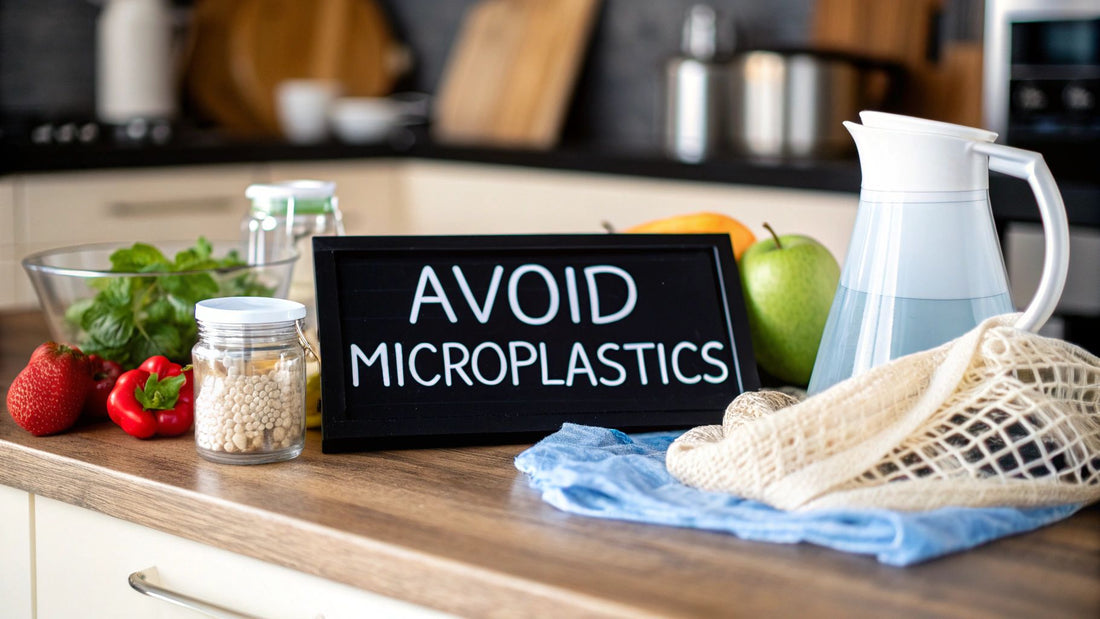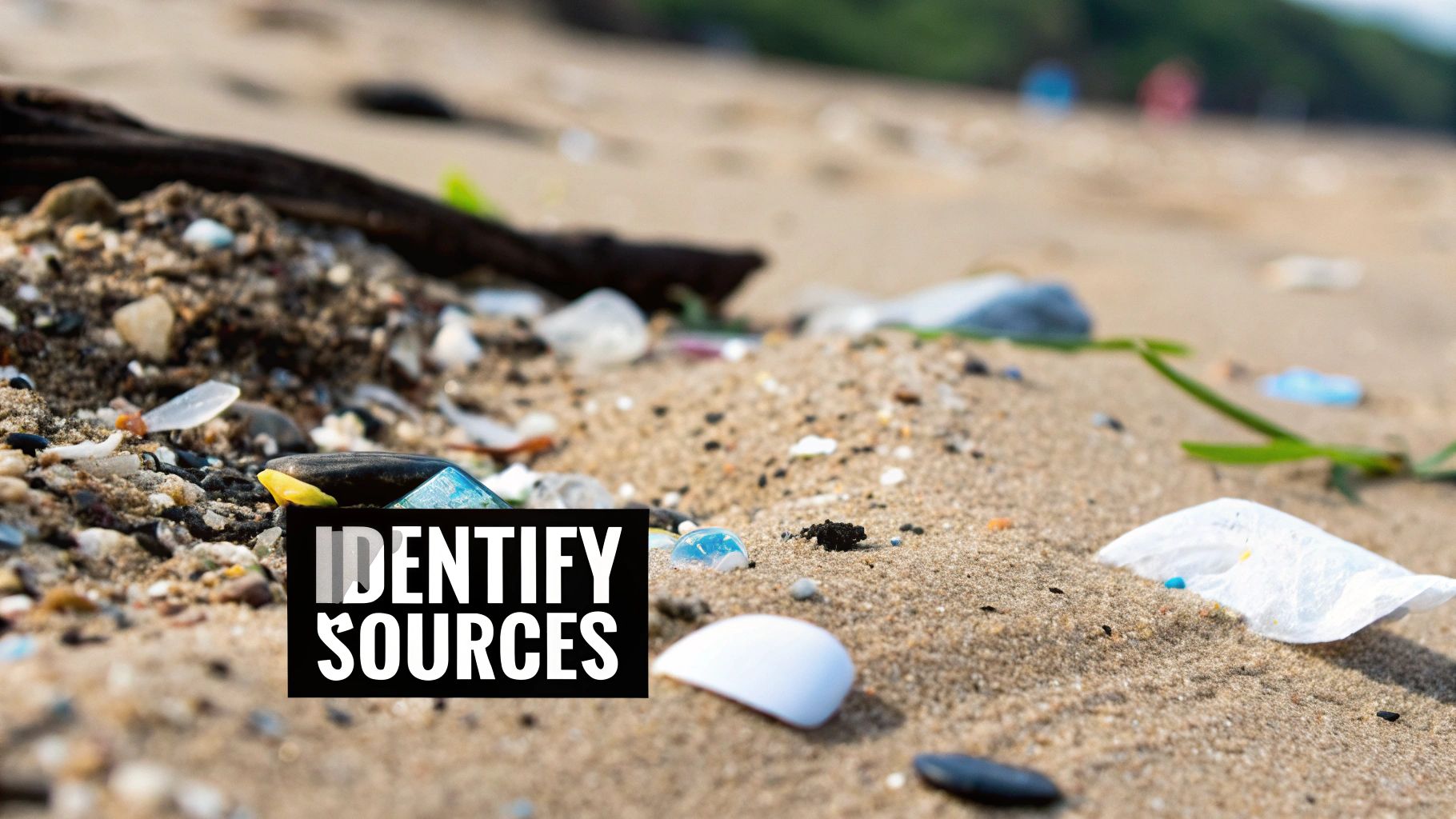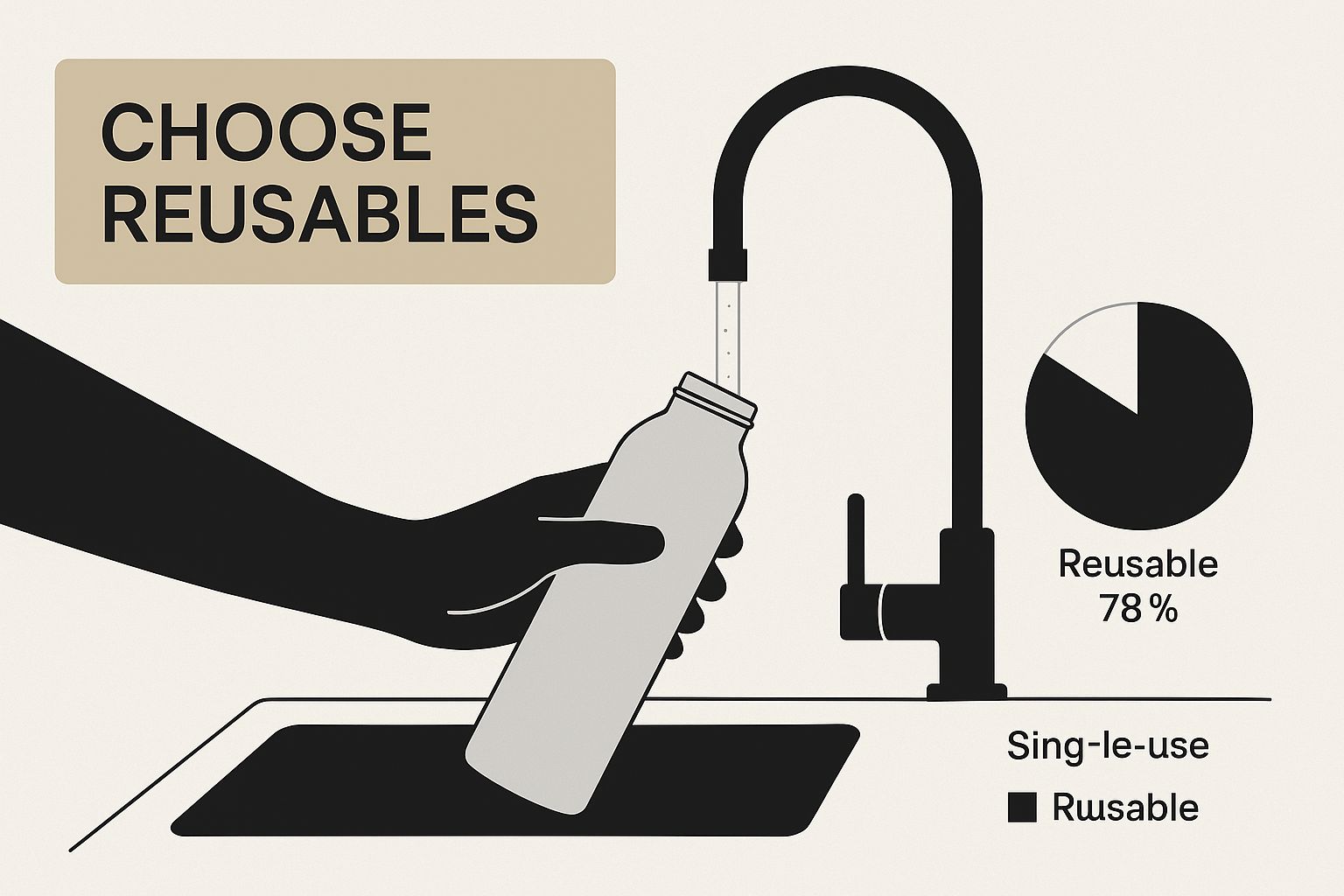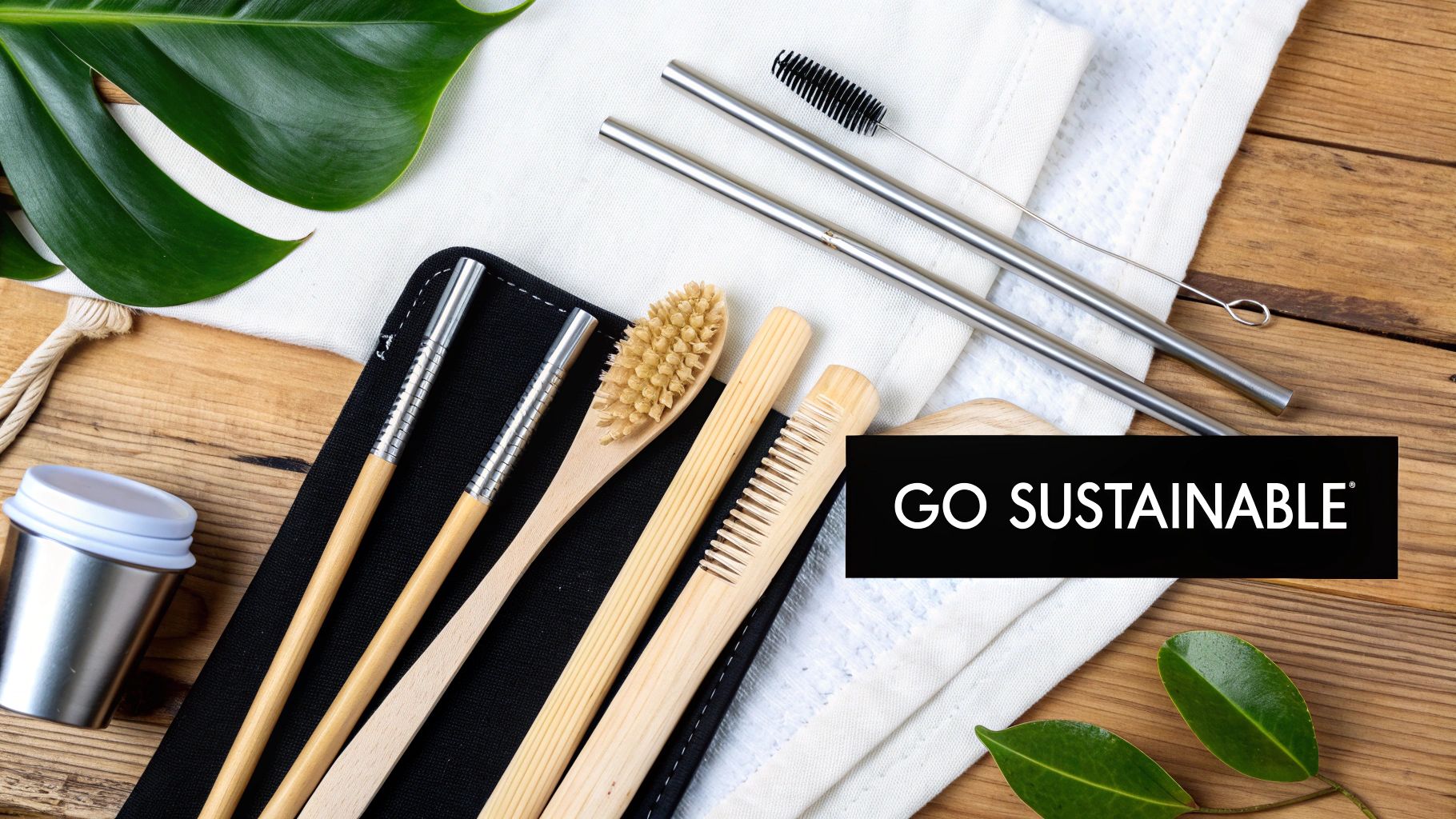
How to Avoid Microplastics: Top Tips for Clean Living
Share
The Shocking Reality of Microplastic Invasion

When you hear the word "microplastics," it's easy to picture something far away—a problem for oceans and marine life. But the truth is much closer to home. These tiny plastic particles are likely in the food we eat, the water we drink, and even the air we breathe inside our own houses. They are a quiet, almost invisible part of our daily lives.
Learning how to avoid microplastics starts with understanding just how widespread they are, often coming from sources we don't think twice about.
From Oceans to Our Kitchens
So, how does a plastic bottle dropped on the beach end up on our dinner table? It's a long journey where larger plastic items break down from sun, wind, and waves into minuscule fragments called secondary microplastics. The scale of this issue is staggering, with an estimated 75 to 199 million tons of plastic waste currently floating in our oceans.
These particles are ingested by small marine animals and work their way up the food chain, eventually reaching us. But it's not all bad news. We've seen that focused efforts can work, like the successful ban on microbeads (primary microplastics) in face washes and toothpaste. You can get a deeper look into the global plastic problem here.
The Unseen Intruders in Your Home
While the ocean gets a lot of media attention, your home is another significant battleground in the fight against microplastics. You might be surprised to learn that some of your daily habits could be contributing to the problem. For instance, when you dust with a dry cloth, you're often just stirring up household dust and sending it airborne, making it easy to inhale.
This isn't just regular dust; it's a mix of tiny shed fibers from everyday items like:
- Carpets and area rugs
- Couches and chairs with synthetic upholstery
- Fleece blankets and curtains
- Our own clothing
Your laundry routine is another major source. Every time you wash clothes made from synthetic fabrics like polyester, acrylic, or nylon, you're sending thousands of microscopic plastic fibers down the drain and into our waterways.
To get a clearer picture of where these particles come from, let's break down some of the most common sources and how they affect us.
Common Sources of Microplastic Exposure
A comprehensive comparison of daily activities and their microplastic contamination levels
| Source | Contamination Level | Primary Entry Point | Reduction Difficulty |
|---|---|---|---|
| Synthetic Clothing | High | Ingestion, Inhalation | Moderate |
| Plastic Food Packaging | High | Ingestion | Low to Moderate |
| Personal Care Products | Moderate | Dermal, Ingestion | Low |
| Household Dust | High | Inhalation | Moderate to High |
As the table shows, our clothing and food packaging are major contributors. The good news is that these are areas where small changes can make a real difference. Now that we know what we're up against, we can start to build our defenses.
Your Water Is Probably Contaminated (But Here's the Fix)
Most of us grab a bottle of water assuming it's the purest choice out there. The labels paint a picture of pristine mountain springs and crisp, clean hydration. The reality, however, is a bit unsettling. That single-use plastic bottle isn't just an environmental headache; it's often a direct pipeline for microplastics.
It’s a strange paradox, but research shows that bottled water frequently contains far more microplastic particles than your average tap water. One major study discovered that a staggering 93% of popular bottled water brands contained microplastics, with concentrations sometimes double what you'd find from the kitchen sink. This contamination seeps in from the plastic bottle itself and during the industrial bottling process. It makes one thing clear: a simple way to avoid microplastics is to stop buying bottled water and filter it yourself at home. The data on bottled water is quite eye-opening.
Choosing the Right Filtration System
Filtering your own tap water puts you back in the driver's seat. The best system for you will depend on your budget and where you live. For homeowners, a reverse osmosis (RO) system installed under the sink is a powerhouse, capable of stripping out even the tiniest particles. If you’re renting or need something less permanent, a high-quality pitcher or a faucet-mounted filter that uses solid carbon block technology is a great alternative. They do a surprisingly good job of trapping microplastics and other contaminants, and they make your water taste better, too.
To help you compare your options, here’s a breakdown of common filtration methods and how they stack up against microplastics.
Water Filtration Systems Effectiveness Comparison
Performance comparison of different water filtration methods for microplastic removal
| Filter Type | Microplastic Removal Rate | Cost Range | Maintenance Level | Best For |
|---|---|---|---|---|
| Reverse Osmosis (RO) | Up to 99.9% | $150 - $600+ | High (Filter/membrane changes) | Homeowners wanting the highest level of purification. |
| Solid Carbon Block | >80% for particles >2 microns | $30 - $100 | Moderate (Cartridge changes) | Renters, budget-conscious users, and good all-around performance. |
| Distillation | ~99.9% | $100 - $300+ | High (Requires regular cleaning) | Individuals needing mineral-free water; extremely effective. |
| Granular Activated Carbon (GAC) | Varies; less effective | $20 - $50 | Low (Frequent filter changes) | Basic taste and odor improvement with limited plastic removal. |
As you can see, both reverse osmosis and distillation offer top-tier removal rates, but solid carbon block filters provide a great balance of effectiveness and convenience for most people.
This is why adopting a simple habit like using a reusable bottle can make such a big difference.

Just filling up a glass or stainless steel bottle from your filtered tap cuts out single-use plastic waste and significantly reduces your daily microplastic exposure.
Don't Forget Your Morning Brew
So you have clean, filtered water. But what are you pouring it into? Your daily coffee or tea ritual could be another sneaky source of plastic. Many people don't know that lots of teabags are sealed with polypropylene, a plastic that sheds billions of micro- and nanoparticles when steeped in hot water. Luckily, a few easy swaps can fix this without disrupting your morning routine.
- For tea lovers: Switch to loose-leaf tea. You can use a simple stainless steel or silicone infuser to get a perfect, plastic-free cup every time.
- For coffee drinkers: Single-use coffee pods are a huge source of plastic waste and potential exposure. A French press (typically made of glass and metal) or a pour-over brewer with unbleached paper filters are fantastic alternatives. Be mindful that even some automatic drip coffee makers have plastic parts that come into contact with hot water, which could leach particles into your brew.
By filtering your water and rethinking how you make your favorite hot drinks, you can take two massive strides toward a cleaner, healthier hydration routine.
Kitchen Makeover: Stop Eating Plastic With Every Meal
Once you've tackled the plastic in your water, the kitchen is the next logical battleground. This is where plastic often rules, from storage containers to cooking utensils. Your daily food prep routine can be a major source of microplastic exposure, and it's not just about the obvious things like cling film. It's woven into the very fabric of how we store, heat, and prepare our food.
Take a look at this image, which probably looks a lot like the inside of most kitchen cupboards.

It’s a sea of plastic, which has become the go-to choice for convenience. But this convenience comes at a cost, and it's a huge reason why we need to be more conscious about how to avoid microplastics in our meals.
Rethink Your Food Storage
That pile of plastic food containers is often the biggest offender. The term "microwave-safe" can be very misleading. It simply means the container won’t melt or warp under heat. It does not mean it won’t leach chemicals and microplastics into your food, a process that actually speeds up with heat. Just picture your Sunday meal prep: you cook a big batch of chili, portion it into plastic tubs, and reheat it all week. Each time you do, you're likely adding a small dose of plastic to your meal.
A much better way forward is to switch to materials that don't interact with your food. Here’s how:
- For leftovers: Switch to glass containers with airtight lids. They can go from the fridge to the oven or microwave (just pop the lid off!) without any leaching risk.
- For lunches: Stainless steel bento boxes are a fantastic, durable alternative. They are lightweight, nearly indestructible, and great for keeping different foods separate.
- For freezing: Glass can sometimes crack when frozen. Instead, look for high-quality, food-grade silicone bags. They are a great, flexible option for freezing everything from soups to berries.
Smart Swaps for Cooking and Prep
Your cooking tools matter just as much as your storage. A scratched non-stick pan can release thousands of plastic particles into your meal every time you use it. In the same way, plastic cutting boards get scarred and grooved by knives. Those little grooves not only shed microplastics directly into your fresh ingredients but can also trap nasty bacteria.
A few simple swaps can dramatically reduce this contamination. Instead of non-stick, choose cast iron or stainless steel pans. They last a lifetime, and a well-seasoned cast iron pan develops a fantastic natural non-stick surface. Swap your plastic cutting board for a wood or bamboo one. These shed natural fibers, and wood even has its own antimicrobial properties. Finally, trade in your plastic spatulas and spoons for stainless steel, wood, or silicone versions, especially when you’re cooking at high temperatures. These changes make sure you taste your food, not your cookware.
Personal Care Products: The Hidden Plastic Factory
Alright, you've tackled the kitchen, but what about the bathroom? That cabinet is often ground zero for a surprising amount of plastic, hiding in plain sight in the very products meant to make us feel clean. It’s a bit ironic, but many of our favorite scrubs, shampoos, and lotions are loaded with tiny plastic ingredients. These wash straight down the drain, entering our waterways and eventually circling back into the environment. Learning how to avoid microplastics here really comes down to becoming a bit of a detective with ingredient lists.
It’s not just the obvious stuff like glitter or visible beads. These particles are often disguised under complex chemical names, used by companies to give a product a certain silky texture or to make it last longer on your skin.
Decoding the Ingredient List
You don't need a PhD in chemistry for this, but it helps to know what you’re looking for. Cosmetic companies use liquid or semi-solid plastics to make lotions feel smooth or to give makeup serious staying power. When you're scanning an ingredient list, keep an eye out for these usual suspects:
- Acrylates Copolymer: This is a liquid plastic used to thicken products or create a film. You'll find it in everything from hairspray to mascara.
- Polyethylene (PE): The very same plastic used for shopping bags, it’s often found as tiny exfoliating beads.
- Polyethylene Terephthalate (PET): You know this one from water bottles, but it's also the main component of most cosmetic glitter.
- Polymethyl Methacrylate (PMMA): These are tiny plastic spheres used to create a "soft focus" illusion in foundations or as fillers in creams.
- Nylon-12: This powder is great at absorbing oil and gives products a smooth, velvety finish.
These aren't just harmless fillers; they're tiny plastics you're applying directly to your body, only to wash them away into our environment.
Simple Swaps for a Plastic-Free Routine
Making a change doesn't mean you have to ditch your entire self-care ritual; it’s just about finding smarter, cleaner ingredients. An easy place to start is with your face or body scrub. Instead of a product with plastic beads, opt for ones that use natural alternatives like jojoba beads, sugar, fine-ground salt, or coffee grounds.
Next, take a close look at your toothpaste, as some whitening formulas rely on PMMA for its polishing power. Look for pastes that use hydrated silica or calcium carbonate instead. For a really effective change, consider a shampoo bar. Not only does it get rid of the plastic bottle, but it also helps you sidestep the liquid polymers often found in conventional shampoos.
If you feel overwhelmed, a fantastic tool is the Beat the Microbead database, which lets you vet products before you even buy them. Making these small swaps is a powerful way to detox your daily routine and cut down your plastic footprint, one product at a time.
Wardrobe Solutions That Don't Break the Bank
It’s a strange thought, but your closet could be a secret source of plastic pollution. Every time you wash synthetic clothes—think polyester, fleece, or nylon—they shed thousands of tiny plastic fibers that flow right into our water systems. Learning how to avoid microplastics here doesn't mean you need to get rid of your entire wardrobe and start from scratch.
Tweak Your Laundry Routine
Your washing machine is the first place you can make a real difference. The friction from aggressive, hot wash cycles is what causes those little fibers to break off and escape. With just a few simple changes to how you do laundry, you can cut down on this shedding by a surprising amount—sometimes by as much as 80%.
Here are a few things you can start doing immediately:
- Go for a Full Load: When your machine is full, your clothes have less room to tumble around. Less tumbling means less friction, which means fewer fibers breaking loose.
- Switch to Cold Water: Hot water is harsh on synthetic fibers, making them more brittle and prone to shedding. A cold wash is much gentler and works perfectly well with today’s detergents.
- Dial Down the Spin Speed: A high-speed spin cycle wrings clothes out with a lot of force. Choosing a lower RPM is a much kinder way to finish the wash.
- Use a Fiber-Catching Tool: This is a game-changer. Products like a Guppyfriend washing bag or a Cora Ball are specifically designed to catch microfibers right in the wash, stopping them before they go down the drain. It's one of the most direct actions you can take.
Shop Smarter, Not Harder
When you do need to buy new clothes, the material you choose makes all the difference. Making a conscious shift toward natural fabrics is one of the most effective long-term strategies for keeping microplastics out of your life.
Instead of synthetics, try to find clothing made from materials that biodegrade, such as:
- Organic Cotton
- Linen
- Hemp
- Tencel (Lyocell)
- Wool
A great way to do this without breaking the bank is to check out thrift stores. Buying second-hand is not only a fantastic way to reduce waste and save money, but it’s also a goldmine for finding high-quality garments made from natural fibers.
Be a little skeptical of broad "eco-friendly" marketing. Genuinely sustainable brands are usually very open about their materials and how their clothes are made. To avoid being tricked by greenwashing, look for trusted certifications like the Global Organic Textile Standard (GOTS). Every small, informed choice you make helps create a wardrobe that’s better for you and the planet.
Creating a Cleaner Home Environment
We’ve talked about how plastics break down from our clothes and packaging, but where do all those tiny fibers actually go? Many of them land right inside our homes, settling into the dust on our shelves and circulating in the air we breathe. Our well-sealed houses can actually trap these particles, which means we might be getting more exposure than we realize. Understanding how to avoid microplastics starts by looking at the very surfaces and air around us.
The Invisible Dust Problem
That dust bunny under your couch is more than just dirt and pet hair; it's a collection of particles, and a surprising amount of it is made of microplastics. These fibers shed from synthetic carpets, furniture, electronics, and clothing. In fact, some studies show that indoor air can be even more polluted with these fibers than the air outside. This creates a constant, low-level exposure for everyone in the house.
Think about a baby or toddler crawling around on a synthetic rug. Their hands pick up fibers from the floor, and as any parent knows, those hands often go straight into their mouths. This hand-to-mouth habit makes young children especially vulnerable to ingesting plastic dust. This is why a few smart cleaning adjustments can be one of your most powerful moves.
Cleaning Smarter, Not Harder
This isn't about obsessive cleaning, but rather about making your efforts count. First, forget dry dusting, which often just pushes tiny particles back into the air. Instead, use a damp microfiber cloth to effectively trap and remove dust and fibers from surfaces. When it comes to vacuuming, make sure your machine is equipped with a HEPA filter. This is a game-changer, as a standard vacuum can just spit the smallest, most problematic particles right back out.
- Try to vacuum high-traffic areas, couches, and rugs at least twice a week to keep up with the shed.
- Opt for simple, natural cleaning solutions like vinegar and water. This helps you avoid adding more synthetic chemicals into your home environment.
- When it's time to replace a rug or buy a new sofa, look for options made from natural fibers like wool, cotton, or hemp.
Purifying the Air You Breathe
For an extra layer of defense, think about adding an air purifier to your home. The most important feature to look for is a True HEPA filter. These are the gold standard, certified to capture 99.97% of airborne particles as small as 0.3 microns, which includes many of the microplastics floating around.
Placing an air purifier in the bedroom or your main living area can significantly cut down on the amount of airborne plastic you inhale. These focused habits help create a cleaner space, reducing your family's daily plastic burden with simple, consistent effort.
Your Sustainable Action Plan
Alright, that was a lot of information. If you're feeling a bit overwhelmed, that's completely normal. The idea here isn't to execute a flawless, overnight transformation of your entire life. Real, lasting change in how to avoid microplastics comes from building small, consistent habits that fit into your actual daily routine.
Prioritize Your Plastic-Free Path
So, where do you even start? The key is to avoid burnout by not trying to change everything at once. Pick a starting point that makes sense for you and offers a big impact for a reasonable amount of effort. Think about your day-to-day life and focus your energy there first.
- For the Busy Professional: Start with what you do every day—hydrating and getting your caffeine fix. Investing in a quality water filter for your home and a reusable bottle for when you're out is a massive first step. Swapping single-use coffee pods for a French press or ditching teabags for loose-leaf tea with a metal infuser are simple moves with a huge payoff.
- For Families with Young Children: Your main focus should be the kitchen and the floors, where little ones spend most of their time. Make it a priority to swap out plastic food containers for glass or stainless steel. Also, getting a vacuum with a HEPA filter is a game-changer for capturing tiny particles. These two adjustments directly target the main ways kids are exposed.
- For Students on a Budget: You can make a huge difference by concentrating on low-cost laundry solutions. Simply washing full loads in cold water and letting your clothes air-dry dramatically reduces microfiber shedding. Hitting up thrift stores for natural fibers like cotton or wool is another budget-friendly way to build a more sustainable wardrobe.
Staying Motivated and Tracking Progress
This is a marathon, not a sprint, and progress can feel slow. That’s why it’s so important to set realistic goals. Try tackling one room or area of your life per month—you could make January your “Kitchen Month” and February your “Bathroom Month.” This approach turns a massive task into a series of manageable, satisfying projects.
Instead of getting hung up on perfection, remember to celebrate the wins. Really notice how much better your food tastes when stored in glass, or how much softer a new linen shirt feels against your skin. These are the small rewards that keep you going.
Finding a friend to join you on this journey or connecting with a zero-waste community online can be a fantastic source of support and accountability. Sharing your challenges and successes makes the whole process feel less isolating and helps your new habits stick, even when life gets stressful.
Making these changes takes effort, especially when it comes to things like grocery shopping. We can help simplify at least one part of the process. For a seamless transition to a plastic-free pantry, check out Naked Pantry. We deliver organic, high-quality staples in completely plastic-free packaging, so you can focus on the rest of your journey.
